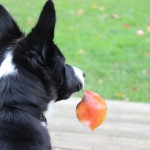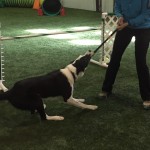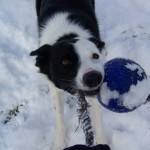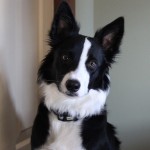There is an inherent nature of dog that we tap into when playing agility and this is it: DOGS ARE PLAYFUL. Picture two puppies playing well together. They chase each other, wrestle and playfully bite. There are frequent role reversals. The puppy being chased becomes the chaser. The puppy on the bottom of the rough and tumble play becomes the one on top. They periodically pause in their play, taking a physical and emotional breather with relaxed, happy looks on their faces.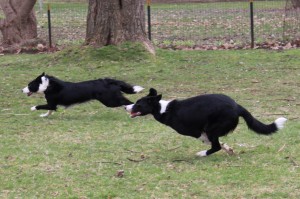
In fact, play is a big part of the development process for dogs as it is for all mammals. But unlike most mammals, dogs continue to play throughout their lives. Just like us humans! And, dogs are wired to play the agility game because they are cursorial predators – they are built to run as they chase prey.
Dog play follows these patterns:
- An invitation to play…with tails wagging, side to side and curvilinear body posture that leads to the ultimate invitation…the play bow.
- Turn and run…chase me!
- Oh…you caught me! Let’s do some wrestling! Or play tug of war with a toy/stick.
- Pause….catch a breath.
- Now I’ll chase you!
The dog’s facial expression is relaxed, eyes are soft, the mouth is open and the dogs are obviously happy!
What can we learn from these observations?
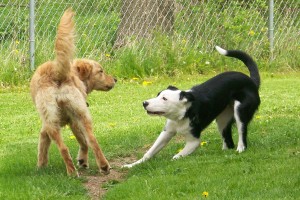 First, during initiation of play, dogs greet each other in a non-threatening way and give an obvious invitation to play.
First, during initiation of play, dogs greet each other in a non-threatening way and give an obvious invitation to play.
Second, dogs play with sincere joy. They enjoy the physical aspect of the game and the unpredictability of what their play partner may do next as they wrestle or cut and run around the play area. They also practice self-restraint while wrestling and biting.
Third, dogs come to us knowing the basic rules of agility handling that can be boiled down to a refined version of a chase game: “I run, you run; I turn, you turn; I stop, you stop”. The adolescent dogs in the series of pictures below had just met and they naturally played by the rules. Our handling is just a refinement of this joyful chase game.

Fourth, most dogs play for short periods then pause and take a break. Pauses are naturally built into healthy play to allow the dogs to catch their breath and regulate emotions.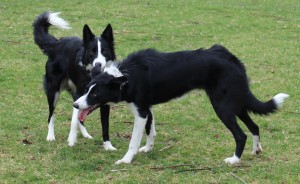
Fifth, if a dog gets too rough during play, the other dog will respond by stopping and turning away. Essentially saying…I don’t like how you are playing and giving the other dog a “time-out”. Clever dogs will modulate the style of play depending on the dog he’s playing with. There may be size, age or temperament differences that the initiator observes and responds to. I’m running too fast? I’ll slow down. Am I chasing you with too much power? Ok, I’ll be gentler. You’d rather be on top when wrestling? Ok, no problem. Did I bite too hard? Ok, I’ll go easier. Need a break? Ok. In other words, the initiator…if he wants a playmate needs to find a way to make it fun for the other dog.
How do these observations help us play with our dogs?
Invite your dog to play
 What is your version of a play bow, that invitation to your dog to play the agility game? Know what your dog responds to, what your dog sees as fun. Is it a quick game of chase? An invitation to tug? A bit of body play? A quick bit of retrieving? An excited, happy voice? A body posture that says, “game on!”? A nose to hand touch? Quick, snappy heeling?
What is your version of a play bow, that invitation to your dog to play the agility game? Know what your dog responds to, what your dog sees as fun. Is it a quick game of chase? An invitation to tug? A bit of body play? A quick bit of retrieving? An excited, happy voice? A body posture that says, “game on!”? A nose to hand touch? Quick, snappy heeling?
There is no single formula. Observe what your dog responds to and find several games that you can use…interactions with you that are pleasurable for the dog and that serve to get your dog into a state of arousal suitable for playing agility. For dogs that like to play with toys and are easily aroused, this is an ideal time to insert some specific rules into the play session. Ask for a quick sit before tugging or teach control games like taking and releasing the toy on cue. For dogs that love food, be sure to get the dog in the right frame of mind for agility by playing games of motion – like fast heeling — before rewarding with food. For dogs that tend to quickly get flat after this initial play session, try to transition smoothly and quickly from the invitation to play to the chase game of agility. Know your dog’s style of play and what is motivating.
Play with joy.
Agility is a team sport. Smile at your dog and laugh out loud while playing the agility game. Stay connected. Agility is a physical sport. Give your dog your energy and he will respond in kind.  Keep your dog engaged. Be unpredictable. When running sequences, sometimes start with a sit-stay; sometimes a down-stay; sometimes run with your dog. Reward in the middle of a sequence. If you make a handling error, cut the sequence short but try not to let the dog know a mistake was made. Be careful not to dampen the dog’s enthusiasm by giving mixed signals. If you need a break to re-think, don’t just stop and ignore your dog (giving him a time-out). Instead, praise your dog and ask him to relax for a minute. Celebrate each and every effort. Bring the same playfulness to agility as you might to casual play.
Keep your dog engaged. Be unpredictable. When running sequences, sometimes start with a sit-stay; sometimes a down-stay; sometimes run with your dog. Reward in the middle of a sequence. If you make a handling error, cut the sequence short but try not to let the dog know a mistake was made. Be careful not to dampen the dog’s enthusiasm by giving mixed signals. If you need a break to re-think, don’t just stop and ignore your dog (giving him a time-out). Instead, praise your dog and ask him to relax for a minute. Celebrate each and every effort. Bring the same playfulness to agility as you might to casual play.
Tap into the chase game
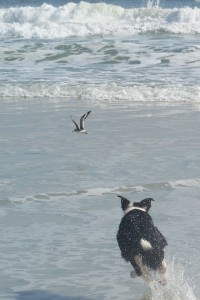 Dogs vary in their inherent desire to play chase games, run and jump but they all have it to some degree. Inserting playfulness and building value for those games can start with your puppies. Away from agility obstacles, teach your dog the basic agility chase game. As discussed above, dogs love to play this game and come knowing the basic rules. “I run, you run; I turn, you turn; I stop, you stop”. The refinements of the chase game will vary depending on the handling system you are using – like teaching the dog not to cross behind you — but these will always include variations of “chase me!”. If I turn, you turn. If I stop/slow down, then a turn is coming…adjust your stride. If I run hard, take the line I’ve set and run! Tap into your dog’s natural chase drive and teach these rules away from equipment using games such as:
Dogs vary in their inherent desire to play chase games, run and jump but they all have it to some degree. Inserting playfulness and building value for those games can start with your puppies. Away from agility obstacles, teach your dog the basic agility chase game. As discussed above, dogs love to play this game and come knowing the basic rules. “I run, you run; I turn, you turn; I stop, you stop”. The refinements of the chase game will vary depending on the handling system you are using – like teaching the dog not to cross behind you — but these will always include variations of “chase me!”. If I turn, you turn. If I stop/slow down, then a turn is coming…adjust your stride. If I run hard, take the line I’ve set and run! Tap into your dog’s natural chase drive and teach these rules away from equipment using games such as:
- Hide and seek…it teaches the puppy: Find me and we’ll play!
- Restrained recalls and all its variations teaches the dog: Chase me and the fun will begin!
- Get that toy! Running together toward a thrown or static toy or food tube and letting the dog win teaches the dog that it’s fun for you to chase him!
- Heeling on both sides teaches the dog to turn in response to your shoulder turns. Start this game from a stationary position, then turn in place and work up to fast heeling and then to running in circles with your dog at your side.
Keep sessions short
Remember how puppies and older dogs play. Their play sessions are broken up with frequent pauses. This is natural for our dogs and it is wise to keep our sessions very short and to build in breaks to keep our dogs fresh mentally and physically. Your sessions may be too long if your dog goes a little flat, walks away or sniffs. Try to keep your dog fully engaged throughout the short training session and end each session with a playful reward. Put the dog in his crate or ask him to relax in a down stay while you plan the next bit of training. Then start the next short session with an invitation to play. If you have trouble limiting your sessions, using a timer or carrying a small number of treats can help.
Keeping a playful state of mind
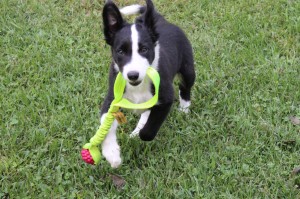 Play is more of a state of mind than an activity. Human Play expert, Dr. Stuart Brown defines play as “an absorbing, apparently purposeless activity that provides enjoyment and a suspension of self-consciousness and sense of time. It is also self-motivating and makes you want to do it again”. Anyone who qualifies for “agility addict’ will appreciate this definition!
Play is more of a state of mind than an activity. Human Play expert, Dr. Stuart Brown defines play as “an absorbing, apparently purposeless activity that provides enjoyment and a suspension of self-consciousness and sense of time. It is also self-motivating and makes you want to do it again”. Anyone who qualifies for “agility addict’ will appreciate this definition!
While it is common to describe agility as a game or to describe our intent to train as “playing agility”, we play at agility because it’s challenging and absorbing. We get a rush when things go well but it can be frustrating when things go wrong, especially if we don’t know why! We enjoy the challenge of figuring out the handling required to successfully negotiate a course. On competition day we are given an “agility test score”, “qualifying points”, “faults”, “wrong courses”, “refusals”, etc. It is natural and expected that we want to be right, run clean and achieve double qualifying scores, minimum yards per second or placements.
But remember that agility is a team sport and one member of the team — our dog — could care less if we qualify or not, if the sequence is run correctly or not – especially since it’s nearly always the handler’s fault anyway – or if we place first or last. Dogs love the game because they want to be with us, they love to run and jump and to play chase games. It is up to us to ensure that the playfulness of agility is not lost on our dogs as we get wrapped up in being “right”.
Next time you go out to train or to compete, take a sense of playfulness onto the field. Invite your dog to play, play with energy and joy, tap into the chase game, keep your sessions short and celebrate each and every effort!
Note: This is a revision of an article originally published in Clean Run Sept 2012
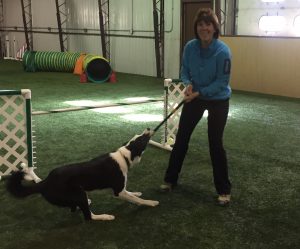 The New Year is often a time for self-reflection and resolutions. One of my resolutions is inspired by observing my dogs in Agility. They are always ready to play, they always try hard, and they always seem to have fun. “Be playful, try hard and have fun!” It’s a mantra I’ll try to live by in my 2017 agility life.
The New Year is often a time for self-reflection and resolutions. One of my resolutions is inspired by observing my dogs in Agility. They are always ready to play, they always try hard, and they always seem to have fun. “Be playful, try hard and have fun!” It’s a mantra I’ll try to live by in my 2017 agility life.








